Golden Agers and Silver Surfers
Old age and aging in contemporary art
9.8. —
4.10.2009
Although the exhibition Golden Agers & Silver Surfers focuses on a certain age group and target population, it develops a dialogue that involves all age groups. Aging is a phenomenon of societal relevance that is given pictorial reflection in the visual arts. While the art of our time mirrors the yearnings and desires of humankind, it also has something else to propose, something proprietary and, perhaps, strange, which stands in juxtaposition to our societal reality.
The fact that western societies are aging is of demographic relevance. People live to a higher age, they stay fit and healthy for a longer time, and they are claiming more self-determination for the so-called “third age”. Twenty years from now, the baby-boomers are going to seek retirement. Western society will probably consist of a majority of people over the age of 60. People born today have a 50 percent probability of living to the age of 100. What is the future of people who have increasingly longer life-spans? Futurologist David Bosshard believes that there are many indications that the inventors of the youth culture will also be the founding generation of a new age culture. It is already a fact that future “golden agers” will experience a completely different reality: they refuse to get old and are committed to a rigorous regime of “power aging”. They lead active lives and do sports. They travel, consume, care for their body and are as exposed to the pressure of competitive beauty as younger people.
Until the early 20th century, old age had a permanent place in art history as a subject for artists. After all, old age represented values such as achievement and wisdom. Whoever managed to get old was considered successful, intelligent or smart, and enjoyed a heightened image in society because of their greater experience of life. It was in the Renaissance that artists started to turn away from the image of age: that period’s interest in the here and now was not only linked to a secularisation of culture but also to a growing glorification of youth. This being said, Hans Holbein the Younger, drew the viewer’s attention to old age in his portrait of the 88-year-old John Chambers, personal physician to the English king, with the prominent inscription "ETATIS SUE 88". In 16th century Venice, old age meant even more than any other stage of life. Venerable old age dominated most of the body politic and was also portrayed in a great number of paintings created in Venice at the time — a particularly impressive point in case being Tintoretto’s Old Man and Boy. Since the beginning of classical modernism and especially since the rise of the generation of 1968, old age has disappeared almost completely from the iconography of art — which is in paradoxical contrast to the social virulence of the issue. This is why we want to invite artists who have explored the image of old age and aging in different manners and also reflect on the societal issues.
The exhibition Golden Agers & Silver Surfers covers a broad and international range of — particularly young — artistic stances to illustrate this discrepancy. Some artists approach mortality in an essayist or symbolic manner (Gabriela Gyr, Melli Ink, Bruno Jakob), others explore the processes involved in aging (Charlie White, Julika Rudelius, Keren Cytter), or — quite literally — inscribe age on their young bodies (Miwa Yanagi). Some artists deal with the institutions in our societies that have been established for old people (Anna Winteler, Thomas Müllenbach), others with the individual or personal idiosyncrasies of age (Gitte Villesen). The fact that we need new standards for aging becomes very clear in the work of a young generation of painters. With a fresh brushstroke and a humorous twinkle, Paul Pretzer and Ryan Mosley bring the age issue back from its iconographic marginalisation.
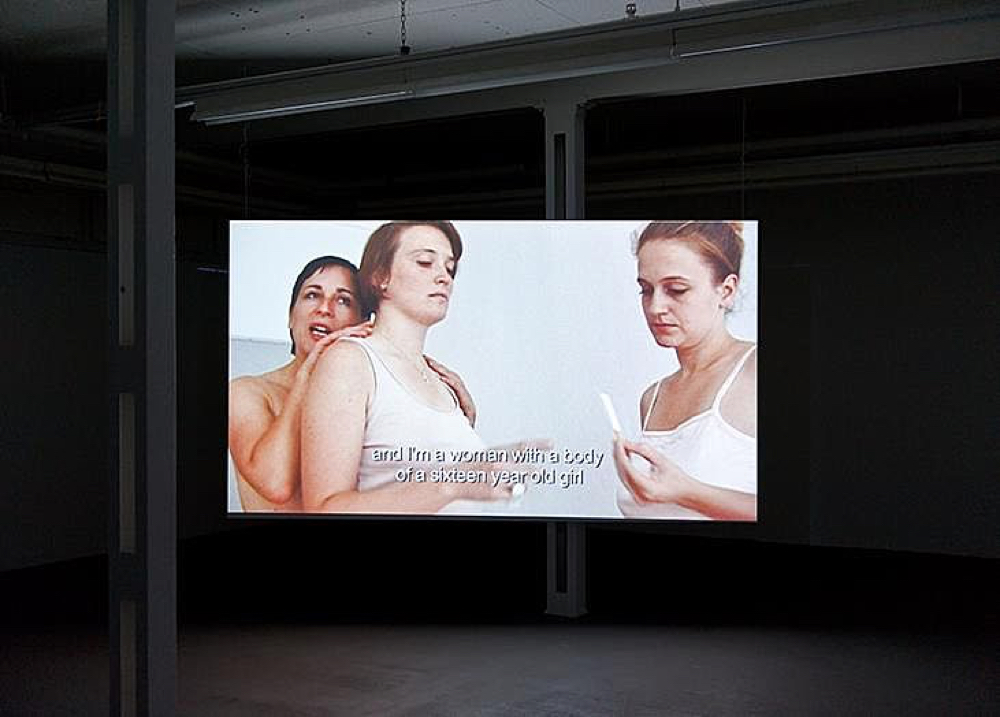
The film Der Spiegel (The mirror) by Keren Cytter (*1977 in Tel Aviv/ISR, lives in Berlin) focuses on a woman around 40 who is confronted with her aging body. While she has still been feeling like a girl just recently, her image in the mirror and the voices of three other women tell her that this feeling is not to be trusted. She should start coming to terms with the fact that she is aging. The desire for a young body and the love of a man are at the centre of the film. The other women comment on her feelings and are continuously trying to manipulate the protagonist. As the ‘voice’ of a pitiless society, they are driving the woman into emotional turmoil. The action reaches a climax when two men appear on the scene. Keren Cytter sets the theatrically condensed plot in an almost empty room. The only props are the mirror and the camera itself. Society is represented by the looks and comments from the others. Time and again the dichotomy between how the protagonist perceives herself and how she is seen by others is highlighted; the relationship between the individual and her social context is staged as a continuous process of collapse.
Text by Sabine Schaschl
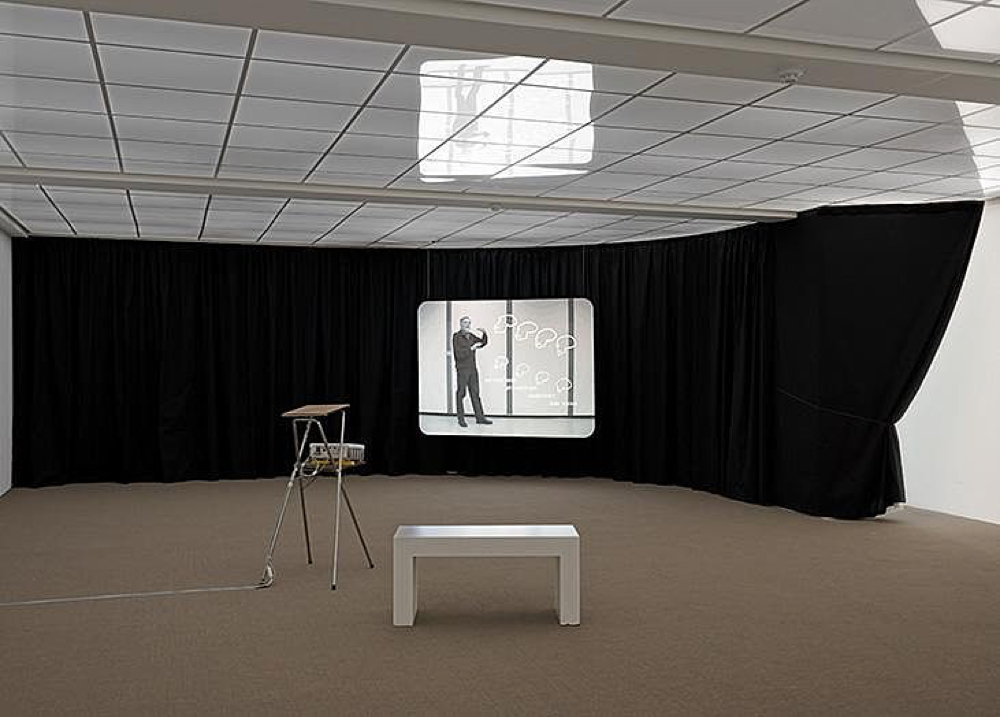
In his video Über die aus der Zukunft fliessende Zeit (On time flowing in from the future) Manuel Graf (*1978 in Bühl/Baden/Germany, lives in Düsseldorf) portrays his former teacher Ekkehard Wallat, who is lecturing about the theory of evolution proposed by O.H. Schindewolf, a contemporary of Darwin. Wallat explains about the aging process of humanity on the basis of the differences in the skulls of children and adults of Australopithecus, Pithecanthropus, Neanderthal man and Homo sapiens. In each species, the development of the skull from infant to adult is linear, i.e. from small and delicate to large and chunky. If one compares, however, an adult skull of Australopithecus with that of Homo sapiens, the development is reversed. The latter looks like a child’s skull in comparison to Australopithecus, which is why the scientist speaks of a “rejuvenation” process. In the second part of the video, Ekkehard Wallat explains the same theory by using the example of plant development and summarises that time flows in two directions: one is towards getting older, the other towards getting younger. Manuel Graf illustrates this content with graphical animations which seem to take on a life of their own in some places. The introduction of the video is also animated: the Falling Water House by Frank Loyd Wright meets the Theodor-Heuss Bridge in Dusseldorf, which in turn meets the House of the Overseers of the River Loire by Ledoux. The fade-out is dominated by the Coldplay song “I’m going back to the start” — which ties in well with the fact that there is an evolutionary rejuvenation while humanity is aging.
Text by Sabine Schaschl
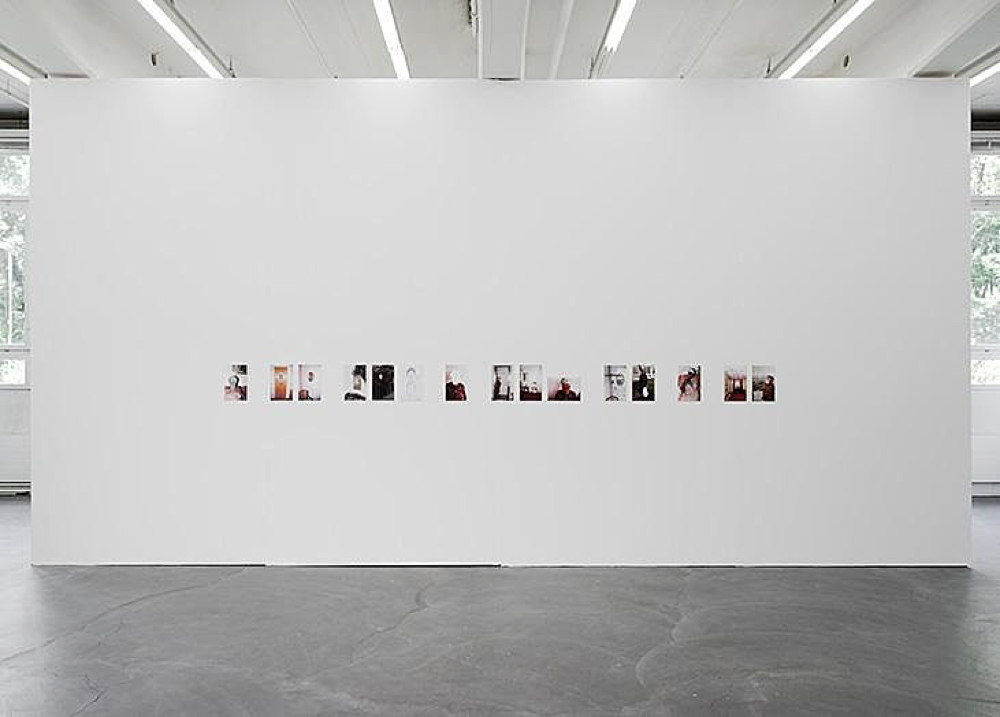
In 2004, Regine von Felten (*1980 in Thun, lives in Thun) started to work on the extended photography project Pilze haben keine Blätter (Mushrooms have no leaves) with her dementia-suffering grandmother. In irregular intervals, the artist takes pictures of her grandmother’s environment and shows her the photos when she goes to see her at the old people’s home. While talking to her granddaughter, the grandmother works on the photos with chalks, felt-tipped pens and scissors. She is aware of her forgetfulness and looks at herself and her handicap from an ironical distance. The self-diagnosed mindlessness translates itself on the photographs into cut-out or over-painted heads. Backgrounds are deleted and individual thoughts are noted down in suitable places. Mushrooms keep cropping up — they grow where the forgetfulness starts or, in other words, where the suppressed consciousness, which has so far denied creative activities, is being forgotten. The experimental images, which touch the viewers at the emotional and at the intellectual level, confront us with our own fragility and a disease which is often surrounded by taboos in our society.
Text by Sabine Schaschl
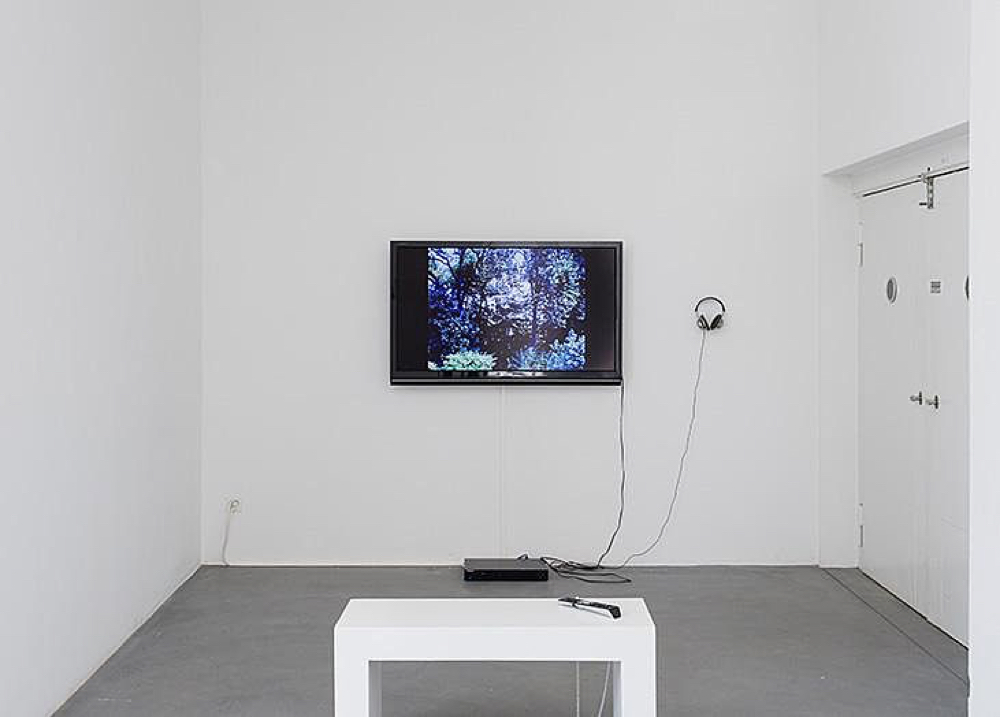
Gabriela Gyr (*1963 in Luzern, lives in Luzern) describes the last visit to her grandfather’s place in Toronto in the form of ‘gaps’. Termed a ‘small essay’ by the artist, the video is strongly marked by the characteristics of an audio-book. The one visual motif — trees swaying in the wind — changes only when the light changes. The reduction of the visual element increases the significance of sound. The voice of the speaker introduces the listeners to a scene marked by small intimate moments between grandfather and grandchild. We hear the peeling of tomatoes being turned into an almost meditative action, and we hear the grandfather ask question after question, as if he felt he was running out of time. The situation comes to a head when there is a visit to the emergency room on the next day. We are not told about the outcome and, like the narrator, are left with the observations described, our own assumptions and the mood they induced.
Text by Sabine Schaschl
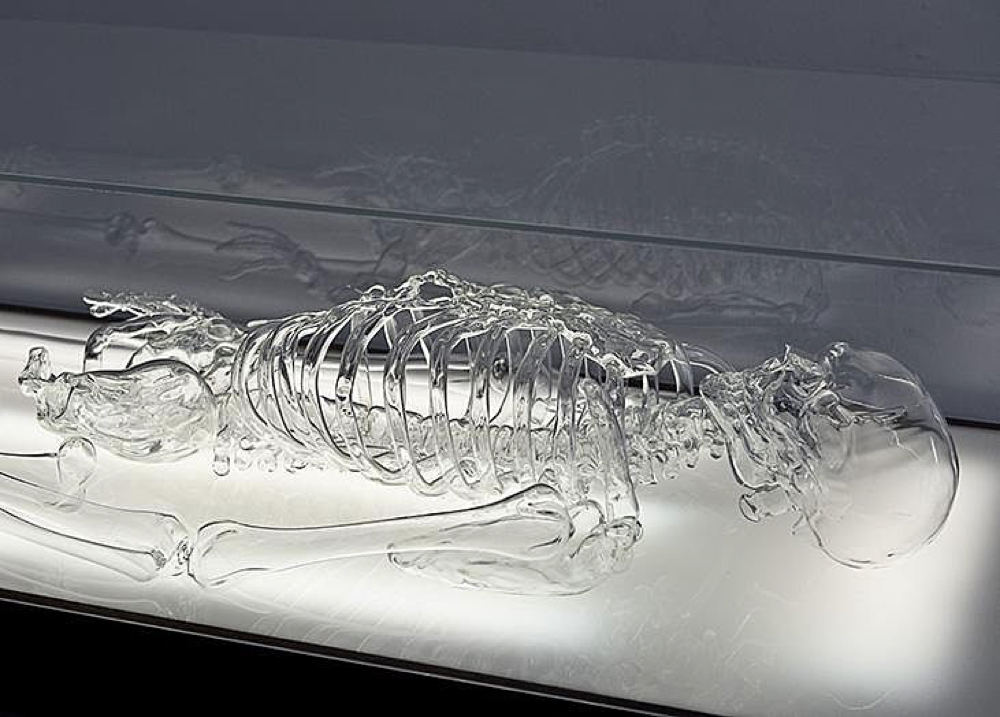
Melli Ink (*1972 in Innsbruck, lives in Zürich and Berlin) has been working on a contemporary approach to the vanitas theme for several years and in diverse media. The transience of all earthly things was an important issue in the arts up until the 18th century and disappeared only when society became secularised and the more mundane questions came to the forefront. Since 1760 approx., the overcoming of vanity has been placed at the centre of bourgeois high-culture, and older vanitas motifs are often attributed to a somewhat less appreciated popular culture. Melli Ink’s drawings, installations and sculptures skilfully play with the question of disappearance or vanishing, in every sense of the word. Death has no place in an enlightened society; in the mundane paradigm it is regarded as the ‘worst case’ that should be avoided as long as possible. Melli Ink’s Skulls, hearts or skeletons of glass are delicate objects of heartrending beauty. In their fragility they show that, ultimately, humans have no control over life.
Text by Christoph Doswald
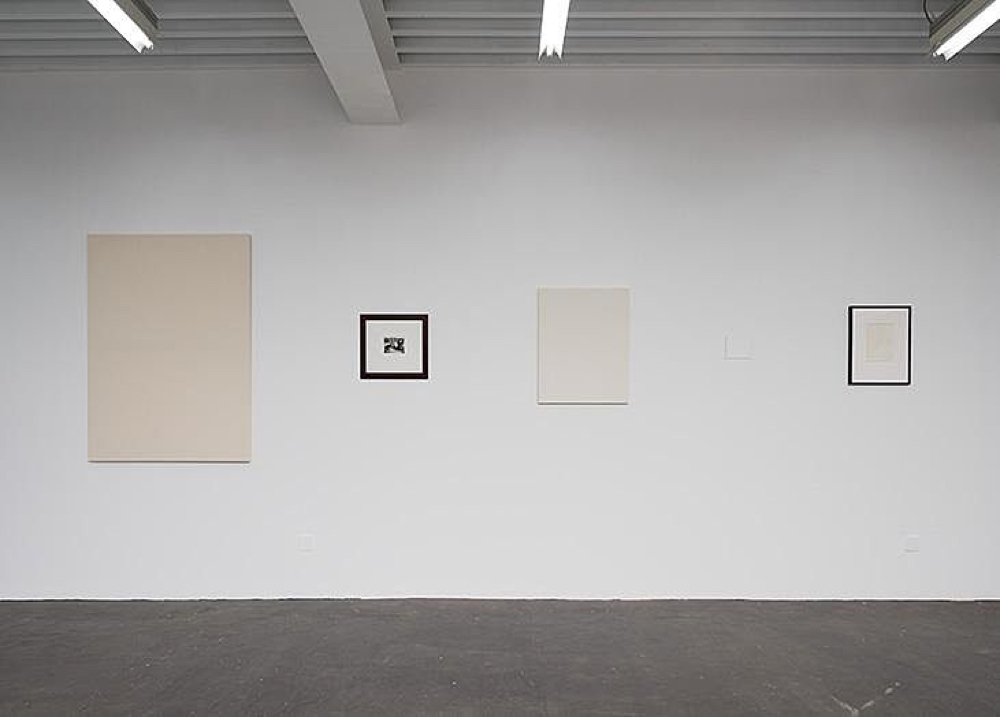
Based in New York since 1983, the Swiss artist Bruno Jakob (*1954 in Jegensdorf, lives in New York) has been working for some time on so-called ‘invisible paintings’. He paints with snow-water or lets his pictures charge themselves with the energy of the painted subject. Besides the reflection on the media, his long-term projects also involve issues such as the loss of images, memories and history. The five-piece set shown at Kunsthaus Baselland is called 7 Days of Death/At the Grave 1989—1994 and has a special place in this investigation. The point of departure for the works created in five different formats and techniques was a particularly significant moment in the life of the artist — the death of his mother. Jakob created the photograph, the paper piece and the three canvases during the wake at his mother’s deathbed. With his work he tried to absorb the energy that was leaving his mother’s body. For his quasi-invisible portrait he used the water that had been used for washing her dead body.
Text by Christoph Doswald
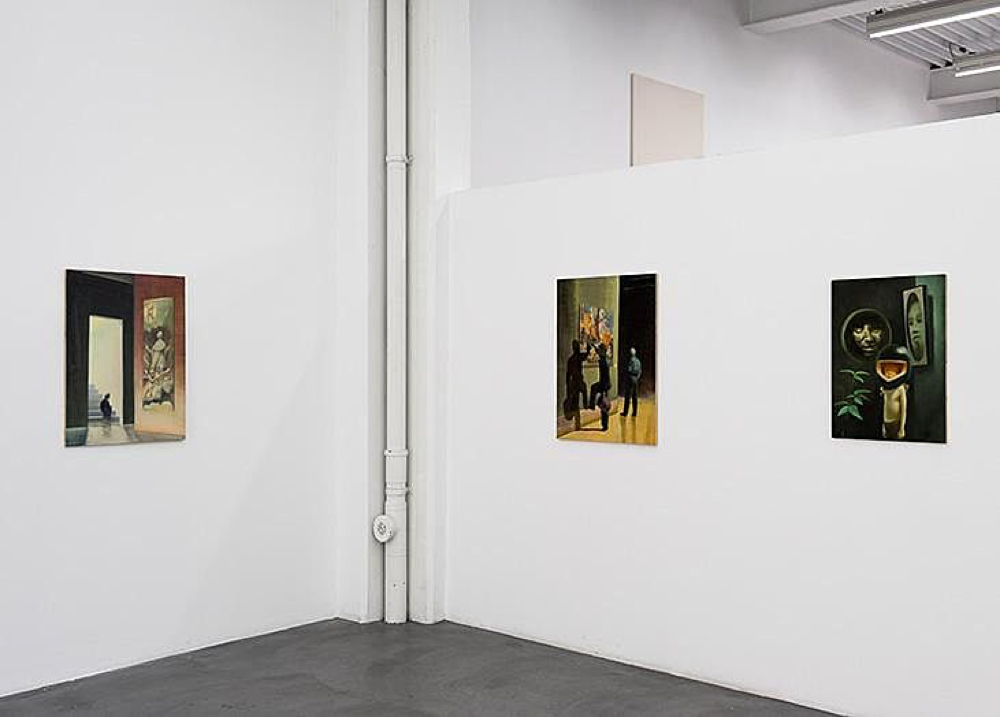
The painter Stephan Melzl (*1959 in Basel, lives in Frankfurt) sees the world from a disquieting perspective. His images are peopled by creatures that may have seemingly young bodies, but a closer look reveals that they already carry the knowledge of aging and mortality. Boys who smoke and muse on ascension to heaven; young girls who lift their skirts and show their untainted pubic area — and yet, they have grey hair. “Their intimate, mystic tone is unsettling”, notes curator Dorothea Strauss. “Stephan Melzl’s work exemplifies the power of images to transcend rational thought. For the depiction of inner states and fantasies he construes figurative worlds of a strangely melancholic and yet humorous nature… They are speaking to us of a fragmented, ambivalent state of coping with outer and inner reality”.
Text by Christoph Doswald

The painter Ryan Mosley (*1980 in Chesterfield, lives in London) is working on a redefinition of the depiction of the figure in a manner that has been called “hyper-figurative psycho-cubism” (Richard Dyer, Artreview). Reminiscent of art nouveau ornamentalism, his paintings also involve a number of other elements borrowed from art history — among others, the tradition of baroque vanitas paintings that becomes manifest in the recurrent use of skulls of all colours and sizes. Comparable to Arcimboldo’s hybrid constructions generated from a multitude of different creatures and objects, Ryan Mosley’s figures are of ambivalent origin — multiple personalities whose faces carry the traces of a both cultural and physical process of aging.
Text by Christoph Doswald
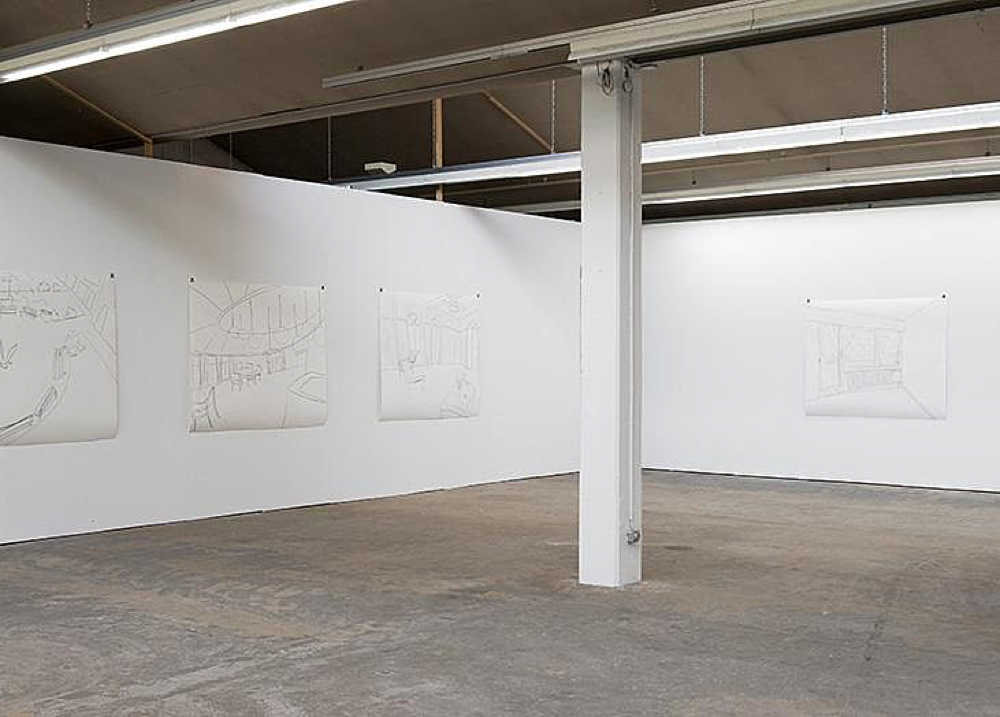
The pictorial worlds produced by the painter and draughtsman Thomas Müllenbach (*1949 in Koblenz/GER, lives in Zürich) on the basis of small-format photographs, deal with our everyday life. He is not primarily concerned with portraying experiences or anecdotes, but with the metaphorics of structures and mechanisms by which our lives are influenced without becoming part of them. Particularly Müllenbach’s large-format graphite drawings, which the artist creates on the floor of his studio, focus on spatial situations that feel familiar but always remain unknown: airplane cockpits, operating theatres, high-security labs, solar reactors, positron emission tomographs, nuclear waste facilities. Now and then a profaner world emerges and Müllenbach may draw the odd kitchen. As a rule, however, the artist is interested in unusual spaces. They are also the basis of his series on rooms in old people’s homes which he drew for the exhibition at Kunsthaus Baselland. They show rooms in “very trivial, banal large buildings” (Müllenbach) and thus make reference to the still-dominant tristesse of old age.
Text by Christoph Doswald
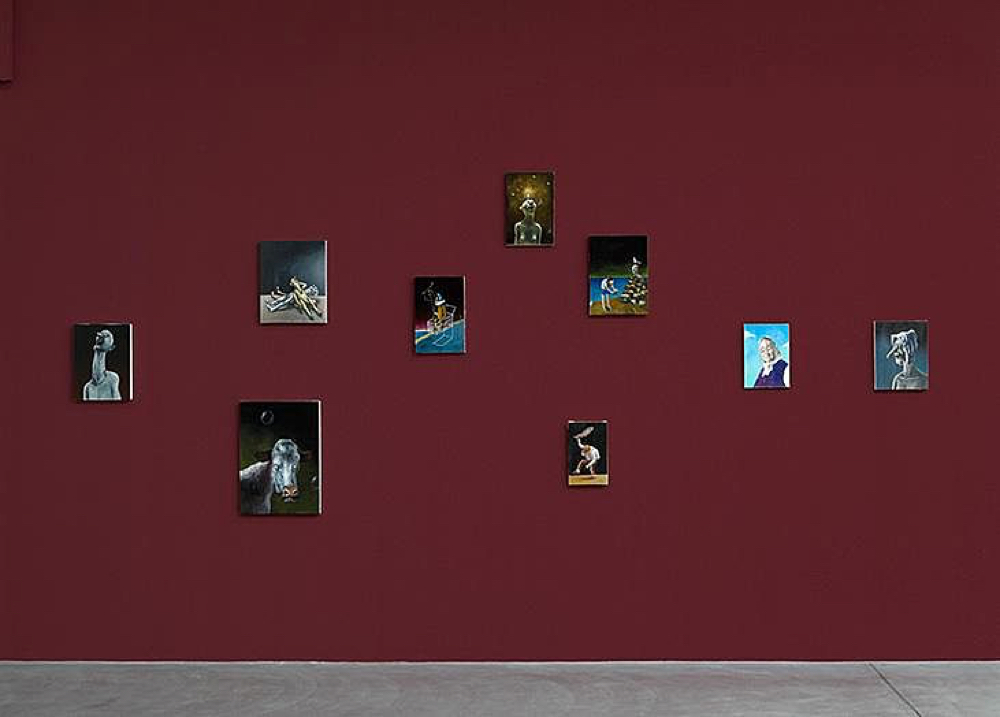
xxx
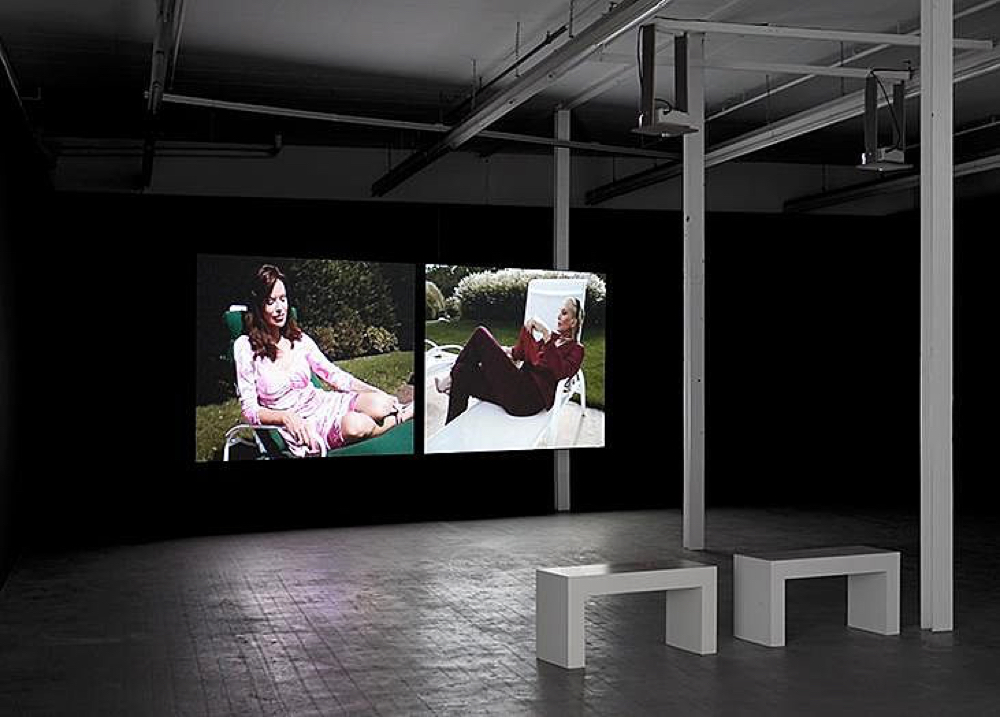
For her video installation Forever, Julika Rudelius (*1968 in Cologne, lives in New York) ‘casted’ five older women who struck her by a certain type of beauty — a beauty marked by an elitist lifestyle and the concomitant opportunities of prolonging beauty and youth. All five women are interviewed in front of swimming pools in the Hamptons, the summer resort of the rich south of New York. We do not hear the questions asked by the artist, but we hear the both stereotypical and very personal answers of the women with regard to beauty and happiness. Rudelius shows the recorded monologues on two projection screens. The subtitles with the text are shown on both screens, while sometimes there are no pictures appearing on one of them and, at other times, the subsequent question is being shown. We witness a dysfunctional dialogue which emphasises the generality of what is being said. We hear and read things like “actually it is all about being happy” or “inner beauty reflects on the outside” and feel reminded of counselling jargon or TV soaps. At second glance, however, the intimate feelings and vulnerability of the women become more perceptible — particularly in the moments when they make Polaroid photos of themselves with a self-timer. We do not see the photographs, but we see them posing for them. Forever confronts us with three different types of viewing: viewing through a video camera, viewing as a recipient, and self-viewing with a Polaroid. We are confronted with the transience of the ‘image’ of womanhood, which is a complex social construction subject to ever new definitions.
Text by Sabine Schaschl
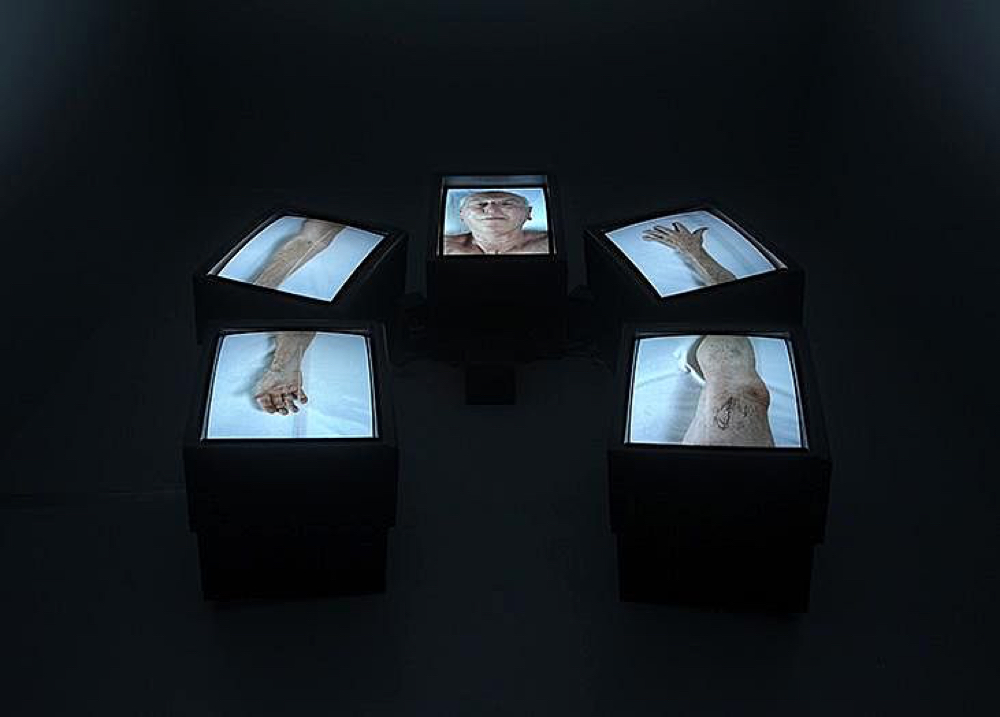
The installation Der freie Fall (Free fall) by Max Philipp Schmid (*1962 in Basel, lives in Basel) consists of five monitors lying on the floor with their screens facing upwards. The action starts with the viewer standing in front of the monitors, observing the images shown at his feet. Shots of wrinkled sheets covering up a body are followed by close-up details of a naked, reclining old man. The images show his head, arms and legs, later also his throat and mouth. From the outset, the editing unsettles the viewer by the disjointed way in which the body is presented. The body shakes, twitches, vibrates and seems to have lost control. Shots of neon-lighting, appearing and disappearing in a flash, just as twitchy and shaky as the shots of the body, evoke a hospital context. Shots of the open mouth of the man flashing up remind us even of dead bodies in morgues. Suddenly the man reappears, this time wearing a suit, surrounded by images of meetings rooms and typical office furniture. His gestures speak of power and influence; then, these apparent memories are shattered by recurrent picture interference and ultimately disappear completely. The images return to the initial view of an old man, wrapped in sheets. The artist uses audiovisual technical manipulations and deliberate picture interferences to enhance the images and their visual impact. Der freie Fall addresses a ‘free fall’ in a social context, the gradual disappearance of power and the experience of a general loss of control — experiences that are particularly impressive in old age.
Text by Sabine Schaschl
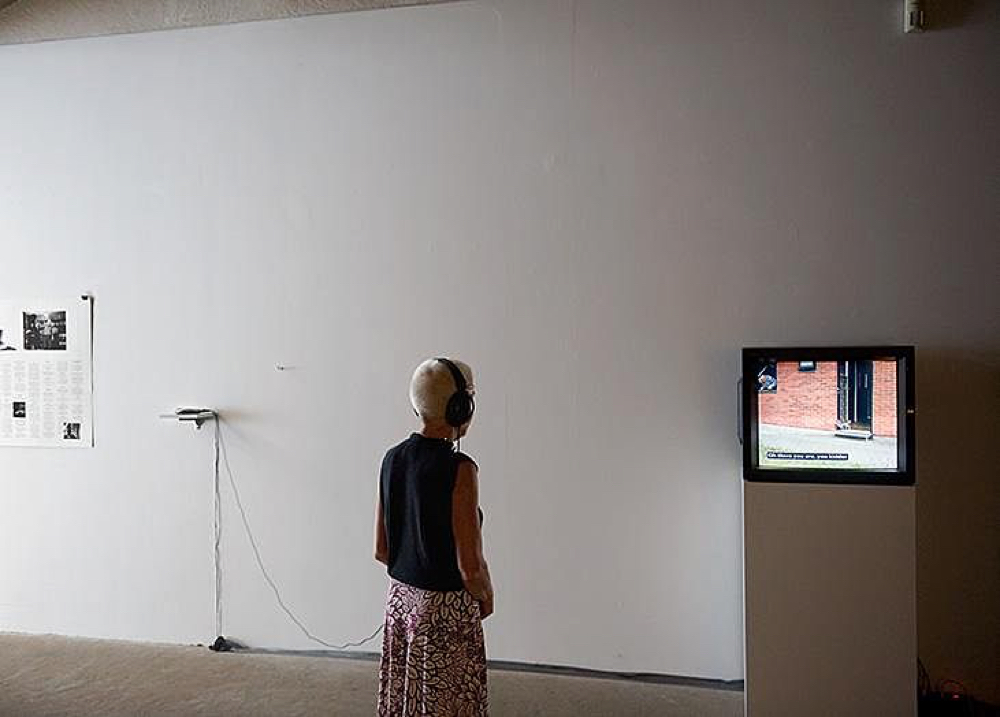
Video is the preferred medium of the artist Gitte Villesen (*1965 in Ansager/DK, lives in Copenhagen and Berlin) who opts for a documentary approach. In her almost unedited scenes she shows us people who are no stars but have adopted a relatively eccentric lifestyle: transvestites, DJs, street musicians, in short, people who deliberately refuse to adhere to standardised rules of living. At first glance, Willy Bøtker, with whom Villesen made a number of videos in 1994, does not seem to fall into that category. He looks like your typical next-door neighbour. Villesen went to see the retiree who lives in Billund several times and documented her interviews with him. They portray Willy as an obsessive car aficionado who claims to have owned about 600 cars in the course of his life. She also reveals him to be an exceptionally gifted singer and storyteller, who takes the viewers on a ‘sentimental journey’ with his large record collection. It is a touching autobiographical journey through the music history from the 1950s to the 1970s. Willy’s Motto: “If there is something I love to talk about, it is cars, motorcycles, airplanes...and women and music are all right, too”.
Text by Christoph Doswald
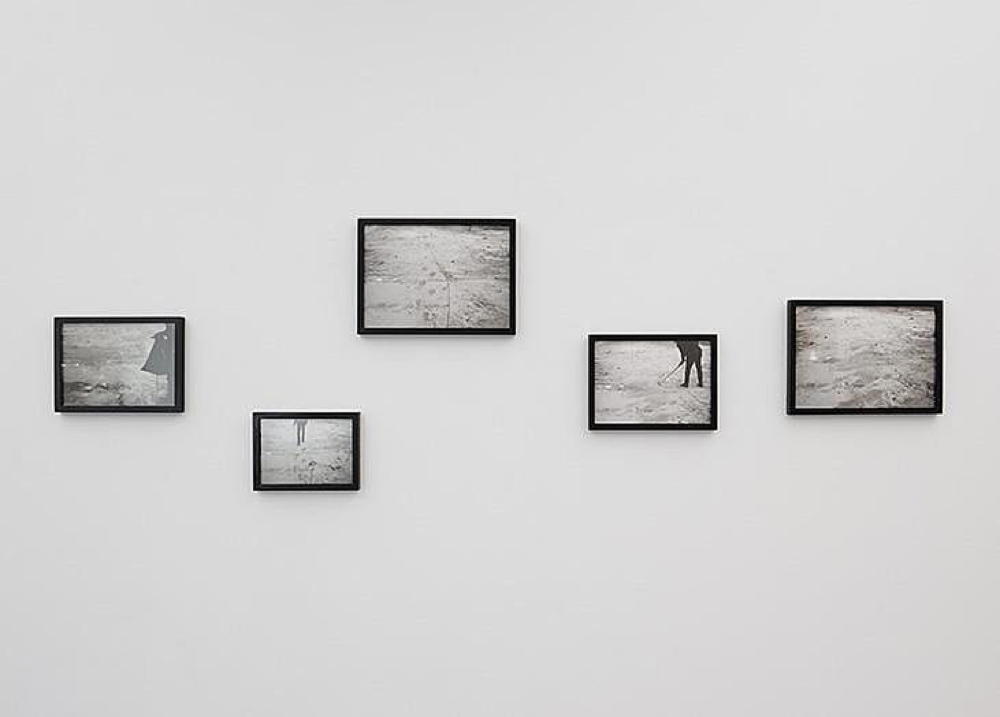
Hailing from Toggenburg, photo-artist Herbert Weber (*1975 in Frauenfeld, lives in Ebnat-Kappel) addresses the fundamental issues of his chosen medium. In this context, Weber usually creates small-format B/W photographs in which he cultivates a role-playing game in the service of pseudo-scientific research. His body serves as an instrument; photography is both the subject and purpose of his research. He climbs on trees, hikes across mountain ridges, investigates an abandoned factory-site, or captures clouds moving across the sky on a moonless night. With his picture-taking and photographed body he creates the topography of his explorations. In its unhurried, painstaking thoroughness, this activity is reminiscent of early 19th-century expeditions. And yet, Herbert Weber is a very contemporary artist whose change of perspective redefines the issue of subject construction and the relationship between the self and its history. There is a deeper meaning to the fact that he takes a first look at the Ewige Jagdgründe (Happy hunting grounds) for this exhibition; he does it in the awareness that the cycles of nature will answer the big questions all by themselves.
Text by Christoph Doswald

In his films, photographs and animated videos, Charlie White (*1972 in Philadelphia, lives in Los Angeles) explores the question as to the impact of the mass media on the construction of the subject. Against the backdrop of the mainstream Hollywood movie industry right in front of his doorstep, this is a particularly pertinent approach. Teen Idols (2008) is a five-piece series of female role-models. White took them out of glossy magazines, crumpled them up and then smoothed them out again after a fashion. Now they show the beauty queens worshipped by teenagers with wrinkled faces in the best tradition of Spitting Image. Despite the simple manipulation, the photographic depictions still raise the question as to their veracity or authenticity. This issue is inherent to the medium. Charlie White’s pictorial worlds hinge on this permanent uncertainty of reception. His works always represent construed images with high reality content — and Homo habilis (2006) is no exception. The reality content does not lie in their authenticity, but in the fact that they carry the phantasmagorical potential of reality, the desire for beauty, happiness and self-actualisation that ultimately determines our lives.
Text by Christoph Doswald
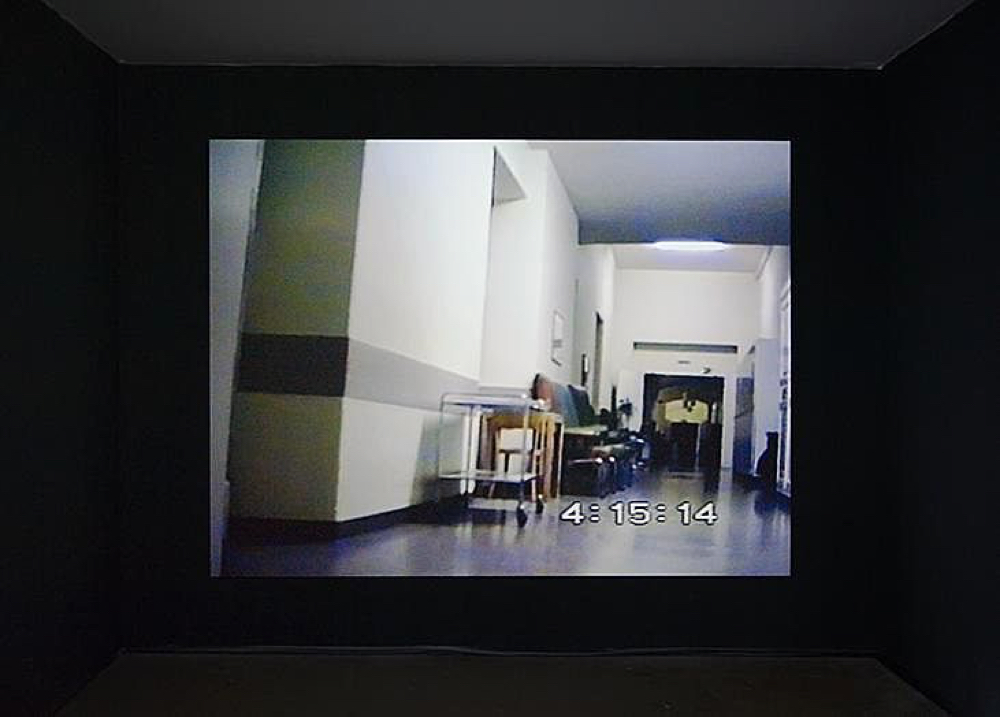
Within the context of the exhibition, Kunsthaus Baselland will also show the last video work by Anna Winteler (*1954 in Lausanne, lives in Basel), before she decided to end her artistic career. Geriatrie 1A — das Hohelied (Geriatrics 1A — the song of songs) from 1991 shows the 24-hour record of a camera mounted on a wheel-chair that is pushed through the corridors of the geriatric unit of the Kantonsspital Basel. Like a metronome, the sound made by the heels of the person pushing the wheelchair underlies the video with a beat. At every hour the camera moves along yellowed halls and rooms and repeatedly approaches the elevator door. The furniture and the interior design testify to a time in the past. In her video, Anna Winteler captures the surge and swell of hospital life: nocturnal quiet turns into hectic morning action, noisy repairs in the afternoon and the return to the more leisurely evening hours. The recurring dolly shots are not only accompanied by the sound of footsteps, but also by a male and a female voice which recite Solomon’s Song of Songs — the book in the Old Testament that describes the courtship of two lovers (Salomon und Sulamith). Winteler’s video is like a simultaneous retrospective and outlook on phases in human life, with the mutual superimposition of images and sound allowing no temporal distinction between loving and aging — but do loving and aging not coincide anyway?
Text by Sabine Schaschl
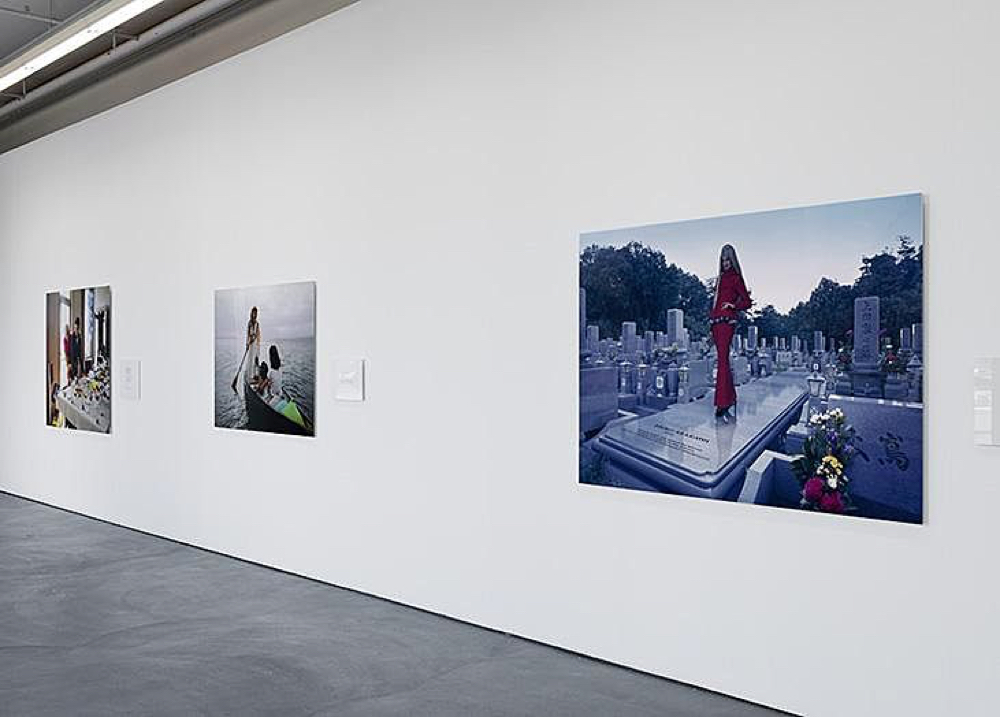
The concept artist Miwa Yanagi (*1967 in Kobe, lives in Kyoto), who currently represents her country at the Venice Biennial, has been looking into the image and role of women in society for quite some time. Against the backdrop of the strictly regulated Japanese lifestyle, she explores the self-image of Japanese women by means of her long-term photographic studies. Shots of real persons inserted into strange synthetically created and digitally edited landscapes and, sometimes, interiors, are used for photo series and occasional monumental images. For the five-piece extract from the series My Grandmothers shown in this exhibition, the artist interviewed young Japanese women about their ideas of aging. These forecasts were translated by Yanagi into staged photographs that she realised together with the authors of these imaginary futures, i.e. with the young women. The interaction of futures in text and images has resulted in an impressive sequence of notions about aging whose visual ambiguity illustrates the anxieties people have when confronted with the issue.
Text by Christoph Doswald